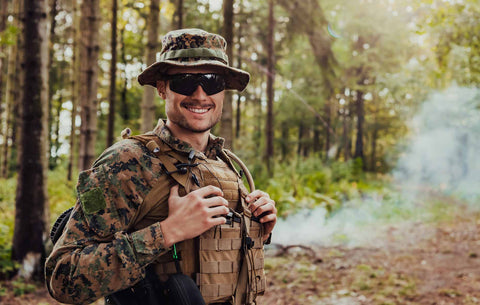In today's world, understanding that human behavior inherently carries risks underscores the importance of taking your safety, and that of your family, into your own hands. Tactical gear, once exclusive to the military and law enforcement, has gained popularity among preppers who recognize its versatility in providing protection.
When someone is serious about their tactical gear, the goal is to maximize safety and employ armor intelligently to achieve optimal speed and protection. This article aims to guide you on how to make the most out of your tactical gear, emphasizing the significance of every pocket and pouch, and the strategic positioning of these elements, as these choices can truly be a matter of life and death.
Exploring Universal Tactical Gear
Tactical gear spans various categories, with some items considered essential for good reason. These versatile, relatively affordable, multi-purpose tools serve as the foundation of tactical gear, which we will delve into shortly.
Universal tactical gear encompasses magazine pouches, holsters, and tactical belts. For firearm owners, these items are of paramount importance as they facilitate the safe and convenient carriage of weapons. Tactical pouches come in various sizes to house magazines, while holsters ensure that your firearm is securely within arm's reach at all times. Consequently, your tactical belt must be thick and sturdy to securely hold these essential items.
Choosing the Right Tactical Belt
While the default choice is often rigger or leather belts, there are numerous alternatives available. The key is to select a tactical belt that's modular and user-friendly for attaching pouches and accessories. For those seeking advanced options, blast belts with PALS webbing offer ample attachment opportunities, although they tend to be heavier than the aforementioned choices.
For both beginners and experienced users, the 2-piece belt setup is recommended. This setup comprises an inner and outer belt, with the former threading through belt loops for enhanced rigidity and waist support, while the latter attaches to Velcro and PALs webbing. Depending on your choice of tactical belt, prices can range from $50 to $400.
Professionals looking for added functionality may opt for load-bearing tactical belts, equipped with retention lanyards to tether them to moving vehicles. These belts, while more robust, are typically slightly more expensive than standard tactical belts.
Pouches and Holsters
When it comes to selecting pouches and holsters for your tactical belt, the options are abundant and should align with personal preferences. Prices for an average holster or pouch can vary from $80 to $200, contingent upon factors such as type, size, and materials used in their construction.
Essential Medical and Communication Equipment
Transitioning beyond the basics, a skill-oriented tactical gear setup almost invariably includes a medical trauma kit, communication tools, and navigation aids. These become paramount if you plan on venturing off the beaten path for an extended period.
A comprehensive medical kit is a critical component of any tactical gear, as it equips you to provide first aid to yourself and others when necessary. While combat medicine requires intensive training, a basic medical kit should contain essentials like bandages, gloves, a sharpie, gauze, trauma dressing, band-aids, and anti-infection medication. Tourniquets, while valuable, can be deferred if you don't anticipate facing gunfire due to their relatively higher cost.
Proper navigation tools are indispensable for outdoor activities such as hiking and camping. These tools go hand in hand with your tactical gear, ensuring you remain in control and capable of summoning rescue if the need arises. Contemporary navigation tools offer convenience and precision, some even syncing with smartphones. However, it's crucial to prepare for circumstances where batteries may fail or electronics break.
Investing in Quality Armor
Now, let's focus on the core components of tactical gear. The level of protection afforded by your tactical gear hinges on the quality of the armor within your plate carrier. The good news is that whether you opt for soft armor or armored plates, you'll benefit from cutting-edge materials and engineering, thanks to significant advancements in tactical gear technology.
The type of plate carrier and plates you select should align with your expected level of exposure to gunfire. For those concerned about fatal gunshot wounds, opting for the highest-level plate carrier is paramount. Conversely, beginners exploring tactical gear for the first time can take their time to compare options and find the right fit for their specific needs.
It's essential to understand that plate carrier protection is categorized into various levels, with Level IIA offering minimal protection against small arms, and Level III providing robust defense against both small arms and rifle rounds. The choice of protection level ultimately hinges on the context in which you intend to use the tactical gear. The key is to find plate carriers that strike the perfect balance between protection, price, and weight.
Your One-Stop Source for Tactical Gear
For a wide range of tactical gear, from belts to plate carriers and more, look no further than ShieldConcept.com. It serves as the go-to resource for both beginners and experienced users of tactical gear. This platform not only offers valuable information on tactical gear usage but also provides access to a selection of high-quality tactical equipment all under one roof.
By following these guidelines and making informed choices, you can effectively utilize tactical gear to enhance your safety and protection.




